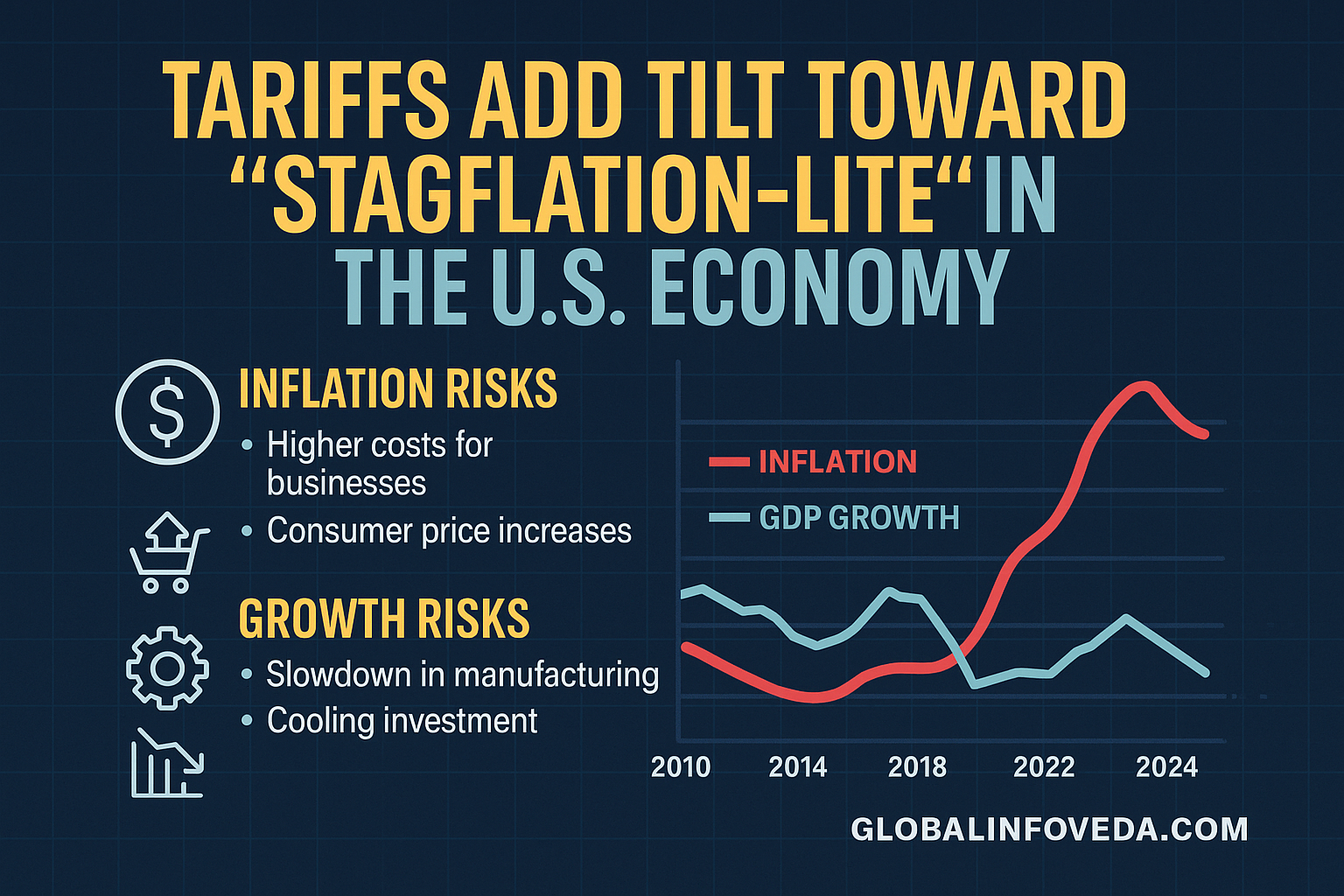Tariffs Add Tilt Toward “Stagflation-Lite” in the U.S. Economy
🏛️ Introduction: The Slow Squeeze
As new tariffs ripple through the U.S. economy, economists are sounding the alarm over a dangerous mix: slower growth paired with persistent inflation—dubbed “stagflation-lite”. While not as severe as the economic malaise of the 1970s, this scenario threatens to erode consumer confidence, delay corporate investments, and hold back wage growth. In contrast to typical inflationary cycles, stagflation-lite combines stubborn price pressures with a cooling economy, making it harder for policymakers to respond effectively.
This blog explores the mechanisms fueling this trend, the sectors most exposed, historical precedents, and the strategic interventions needed to avoid a prolonged slowdown.
📊 Big Picture: Why Tariffs Risk Stagflation
- Inflationary Push: Tariffs elevate input costs, which cascade through supply chains to raise retail prices.
- Growth Drag: Higher production costs dampen profit margins, leading businesses to cut expansion plans.
- Demand Softening: Households rein in discretionary purchases, weakening GDP growth.
- Supply Chain Strains: Longer lead times and disrupted imports slow manufacturing output.
- Investment Retrenchment: Policy uncertainty deters long-term capital commitments.
📌 In context: If GDP hovers between 1.5–1.8% while CPI stays above 3%, the economy could remain stuck in a slow-growth, high-price environment through at least 2026.
🔍 Sectoral Exposure: Who’s Most at Risk?
1. Manufacturing
- Tariffs on steel, aluminum, semiconductors, and industrial machinery raise core production costs.
- Exporters face retaliatory trade measures, curbing overseas sales.
2. Retail & Consumer Goods
- Clothing, appliances, and electronics become more expensive, hitting price-sensitive shoppers.
- Discount and value retailers lose their competitive edge.
3. Construction & Infrastructure
- Imported steel, cement, and specialized equipment cost more, causing project delays.
- Public infrastructure projects risk scaling back due to budget overruns.
4. Agriculture
- Higher costs for imported fertilizers, pesticides, and farm equipment.
- Retaliatory tariffs reduce international demand for U.S. crops like soybeans and corn.
5. Technology Sector
- Hardware producers relying on foreign components face squeezed margins.
- Product launch cycles slow as firms manage disrupted supply chains.
💵 Expanded Economic Impact Analysis
- Persistent Price Pressures: Inflation remains entrenched in goods-heavy CPI categories.
- Lower Growth Trajectory: Reduced consumer demand curtails retail, travel, and service sector activity.
- Profit Margin Compression: Higher costs without equivalent pricing power reduce reinvestment potential.
- Wage-Price Disconnect: Real wages stagnate or fall, limiting household spending power.
- Policy Tightrope: The Fed risks over-tightening, slowing growth further, or under-tightening, letting inflation persist.
📈 Historical Context
- 1970s Stagflation: Oil shocks and wage-price spirals drove double-digit inflation and high unemployment.
- 2018–2019 Tariff Disputes: Raised costs in manufacturing, slowed sector growth, and prompted targeted retaliatory tariffs.
- COVID-Era Supply Shocks: Shortages and bottlenecks created tariff-like effects, with elevated costs and reduced production.
📊 Tariff Impact vs. Baseline Scenario
| Metric (2025-26) | With Tariffs | Without Tariffs |
|---|---|---|
| GDP Growth | 1.7% | 2.4% |
| Inflation (CPI) | 3.4% | 2.1% |
| Unemployment | 4.6% | 4.2% |
| Business Investment | -1.2% | +0.8% |
🏛️ Policy & Relief Measures: Preventing a Slide
1. Targeted Tariff Exemptions
- Remove or reduce tariffs on essential inputs for key industries.
2. Supply Chain Diversification
- Incentivize nearshoring and domestic manufacturing for strategic goods.
3. Consumer & Business Relief
- Expand tax credits, direct aid, and financing programs for affected households and SMEs.
4. Coordinated Policy Response
- Align monetary and fiscal strategies to balance inflation control with economic growth.
5. Export Market Expansion
- Forge new trade partnerships to replace lost export opportunities.
🔮 Final Insight: Managing the Risk
The U.S. is not in full stagflation, but tariffs are nudging it toward a slower, inflation-resistant trajectory. Without carefully targeted exemptions, proactive supply chain reforms, and synchronized macroeconomic management, the nation risks a multi-year period of muted growth, persistent price pressures, and eroded global competitiveness.
📡 Follow GlobalInfoVeda.com for in-depth analysis of trade policy, economic trends, and sector-by-sector implications.
